Klezmer music originated in the 'shtetl' (villages) and the ghettos of Eastern Europe, where itinerant Jewish troubadours, known as 'klezmorim', performed at joyful events ('simkhes'), particularly weddings, since the early middle age till the Nazi and Stalinian prosecutions.
It was inspired by secular melodies, popular dances, 'khazones' (khazanut, Jewish liturgy) as well as by the 'nigunim', the simple and often wordless melodies, intended by the 'Hasidim' (orthodox Jews) for approaching God in a kind of ecstatic communion.
In (mutual) contact with Slavic, Greek, Ottoman (Turkish), Gypsy and -later- American jazz musicians, using typical scales, tempo and rhythm changes, slight dissonance and a touch of improvisation, the 'klezmorim' acquired the ability to evoke all kinds of emotions, through a very diversified music.
Since the 16th century, lyrics have been added to the Klezmer music, due to the 'badkhn' (the wedding master of ceremony), to the 'Purimshpil' (the play of Esther at the Purim celebration), and to the Yiddish theater.
With its artistic copiousness and its distinctive sound, Klezmer music is unique, easily recognizable and widely appreciated, both by 'ethnic insiders' and by larger audiences, all around the world. Klezmer music is also an invitation to dance and undergoes since the 60's a real revival.
Klezmer music and Yiddish songs include nowadays a huge repertoire in which the whole gamut of human emotions can be expressed, from joy to despair, from devotion to revolt and from meditation to drunkenness, notwithstanding love and... Jewish humor!
"Klezmer: it's not just music - it's a way of life!" (Hankus Netsky)
The Bible is rich with description of ritualized instrumental music played in Jerusalem but we don't know how the music sounded like by this time for there was no system of writing (and no recordings!) With the destruction of the second Temple of Jerusalem in 70 C.E. the Jews were plunged into a mourning and refrained by 'halakhic' (rabbinical) orders from rejoicing and using instruments, except for the shofar (ram's horn) on Rosh Hashanah and Yom Kippur.
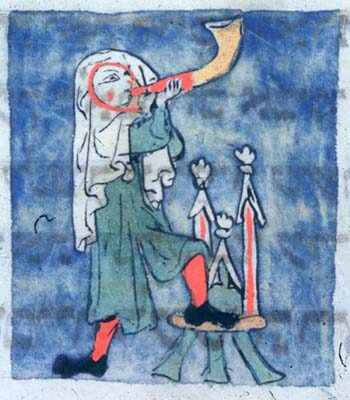 |
shofar |
At the middle age, the music instruments were used again at profane events and some joyful religious celebrations, as Purim, Khanukah or Simkhat Torah. It's asserted that Jewish musicians, professional or not, used to wander through Eastern Europe, from "shtetl" (village) to ghetto to perform at various joyful occasions ('simkhes') like birthdays, new rabbi's or new Torah roll's arrival, celebrity's visit, synagogue's inauguration, circumcisions ('bris') and especially weddings ('khasene'). Often poor and known for preferring alcohol and women to the study of the Torah, they were semi-pariah on the 'yikhes' (social and familial ladder), hardly higher than 'shnorrers' (beggars) and the criminals (Coming from the word 'klezmer', 'klezmeruke' and 'klezmerivke' were used as insults!), but developed also reputation and were greatly demanded: 'Vi der klezmer, azoy di khasene'!
 |
klezmorim |
 |
| |
||
| 18th Century |
On the other hand, there is no traditional Jewish funeral music: A khasene iz azoy vi a levaye, nor mit klezmorim! (a wedding is like a burial, but with musicians!) (Daniel Kahn).
Some of them became celebrities throughout Europe: the flute and 'shtroyfidl' (a home-made xylophone) player Mikhoel-Yosef Gusikov (1806-1837), called a genius by Felix Mendelssohn 1836 in Leipzig, and both fiddlers from Berditshev: Arn-moyshe Kholodenko aka Pedotser (1828-1902) and Yossele Drucker aka Stempenyu (1822-1879) who inspired Sholem Aleikhem's character and whose nickname became synonym of virtuoso. But only a small number of their works remains nowadays!
Pedotser 
|
 Gusikov Gusikov |
In many cities (like Metz, Frankfurt or Prague), the Jewish musician's activity was heavily taxed and restricted as to when they could play and how many or which instruments they could employ.
In Russia, since the end of the 18th century, and as a result of several tsarist edicts (Catherine II, Alexandre I...), more than 5 million East European Jews were confined in a 'pale of settlement', only a few hundred miles around Kiev (Poland, Lithuania, Belarus, Ukraine, Galicia and Moldavia). Furthermore, they were not allowed freely to the important towns. Most of the musicians learned to play strictly by ear 'on duty' and the profession was passed from father to son (as the women's public performances were banned!). They spoke a Yiddish slang ('klezmerloshn') full of anagrams and double meanings. They formed 'guilds', kinds of syndicates, acting as lobbies against the governments and as social mediators.
 A klezmer kapelye (~1910)
A klezmer kapelye (~1910)
At the
end of the
eighteenth century, the Jews were submitted to three different
religious influences:
Westwards, the Maskilim (members
of the Haskalah, the Jewish
Enlightenment movement) of Moshe
Mendelssohn (1729-1786, the composer Felix Mendelssohn's grandfather)
encouraged the
cultural assimilation. Northern, the Misnagdim ('opponents' or
'rationalists'), led by
Eliah ben Solomon Zalman, the Vilna's Gaon (1720-1797), valued the
study of the holy texts
while Eastern, the Khasidim
(pious), followers of the charismatic Israel ben Eliezer, aka
Ba'al Shem Tov (Master of the Good Name, 1700-1760),
placed high value on joy,
songs and dances as paths to express their love for humans and God in a
quasi-mystical
collective ecstasy.
For the Maskilim in Germany, Austria, Bohemia and Moravia, Yiddish and Klezmer had to be supplanted by the Germanic culture. But in Eastern Europe, the Klezmer flourished and borrowed from the Hasidic stream 'nigunim' (wordless melodies), as joy and fervor. They mixed it into an artful mixture with popular songs, profane dance music and 'khazanut' ('khazones'), the cantorial way of singing Jewish prayers.
'Klezmer' is a Yiddish term, combining the Hebrew words 'kley' -vehicle, instrument- and 'zemer' -song-, thus meaning 'vehicle of the song' (A.Z. Idelsohn), i.e. 'music instrument'.

Attention, please: Pronounce 'kleZmer' and not 'kleTzmer'!
This etymology let us imagine that instruments progressively replaced the voices. In a manuscript written in Cracow (Poland) in 1595, discovered in the genizah (books cemetery) of the Ben Ezra Synagogue in Cairo, and kept at the Trinity College of Cambridge, 'klezmer' qualifies for the first time the musician instead of the instrument (Zev Feldman). From that time, one can distinguish between the functions of 'klezmorim' (musicians), 'letsonim' (public entertainers), 'badkhonim' (wedding jesters) and 'khazonim' (cantors) . Since then, this qualification exists in many old and new Yiddish songs. But in 'klezmeloshn', a musician would rather call himself Labushnik or -in a kind of back slang: Balishnik.
The term 'klezmerishe musik' was introduced in 1938 by the famous musicologist Moshe Beregovski (1892-1961) in his book 'Yiddishe Instrumentalishe Folksmuzik' and adapted by Zev Feldman and Joachim Stutchevski ("musiqah qlezmerit") in Hebrew). Opposed to the respected 'muzikant', 'klezmer' qualified an illiterate musician, unable to read notes and playing traditional music by ear. Nowadays, the term is rather laudatory for the musicians and qualifies also the traditional Jewish music of Eastern Europe, as well as all its modern derivatives. (I don’t mean 'derives'!)
However, for the great clarinetist Giora Feidman, 'Klezmer' means that the instruments are essentially the loudspeakers of the 'inner voice' singing in everyone’s soul. A Klezmer doesn’t make music, he speaks, prays, console with his instrument (Helmut Eisel).
 Giora Feidman in Geneva, 2004
Giora Feidman in Geneva, 2004
Although it was marked by a large number of
pogroms
almost everywhere of Eastern Europe, the Yiddish culture, especially
theater, literature,
theater, cinema and, of course, music, was flourishing in the late
nineteenth
century.
Although
Although it did not always happen without conflicts, Jewish musicians used to play with (and for - ) Gypsies or 'Goyim' (Gentiles) and vice-versa.
| Jewish and Ruthenian musicians Verecke, Hungary, 1895 picture: Magyar Néprajzi Múzeum
|
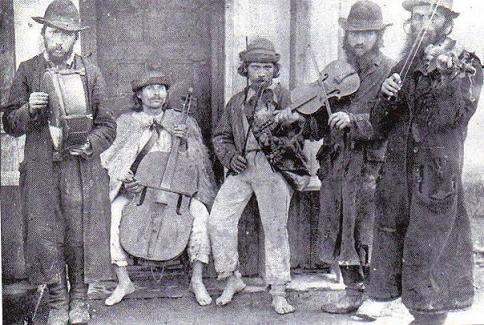 |
But the main function of the klezmorim was to accompany the traditional Jewish events, where they could let their talent flourish. Each circumstance had its proper themes: Tish Nigunim (melodies to be heard at table), Solinski's Rumanian fantasies, etc. during the meals, meditation and concerts, Gasn Nigunim for the processionals and -last but not least - for the weddings: 'Tsu der khupe', 'Fun der khupe', 'Kale bazetsn' and 'Kale badekn' for the bride, 'Mazltov' for the greetings, 'Firn di Mekhutonim aheym' or 'Dobranoc' (gute nakht)', 'Dobriden, es toygt shoyn (Good morning, it already daylight!) for the end of the ceremony, etc.
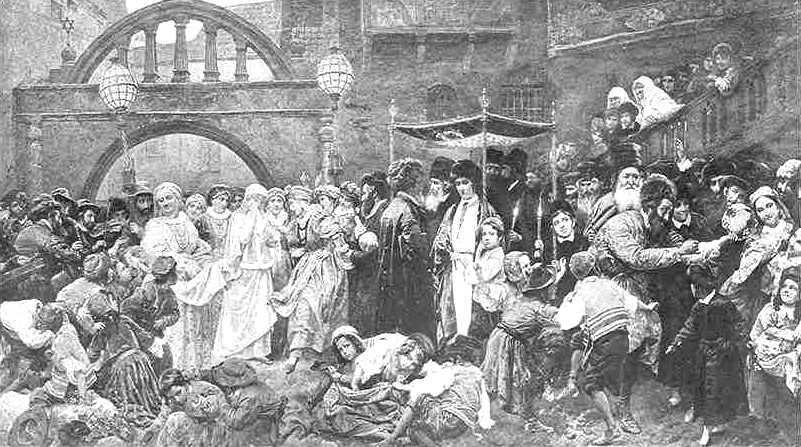 |
a Jewish wedding in Galicia
|
The quality of the musicians -and the wages they could get!- was evaluated by their virtuosity, their repertoire, but mostly by their ability to adapt the music to the listeners and dancers.
| The Klezmer repertoire early included many traditional or recent Yiddish songs. | 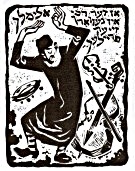 |
Rebbe
Elimelekh |
| Purimshpiler Amsterdam 1723 |
 |
This is not surprising for traditional Jewish weddings were since the 13th century animated by a 'badkhn', master of ceremony who also functioned as jester, rhymester, entertainer, parodist, preacher and indeed singer. Furthermore the feast of 'Purim' (commemorating the liberation of the Jews in Persia by the queen Esther) was, since the 18th century, an opportunity for performances ('purimshpile') where musicians, actors and singers appeared together. |
Many Jews left Eastern Europe in the late nineteenth century seeking for prosperity and, later, flew away from the Nazi and Stalinian prosecutions and established themselves in the United States. These immigrants (Harry Kandel (1885-1943), Abe Schwartz (1881-1963), Lt. Joseph Frankel (1885-1953), Dave Tarras (1897-1989), Naftule Brandwein (1884 or 1889-1963), Shloymke Beckerman (1883-1974), etc...) or their descendants (Max Epstein (1912-2000), Pete Sokolow, Michael Alpert, etc...) made Klezmer survive and even flourish as dance and entertainment music. But the music underwent such deep transformation that we have a very skewed notion of how it sounded in Eastern Europe (Mark Slobin).
Brandwein 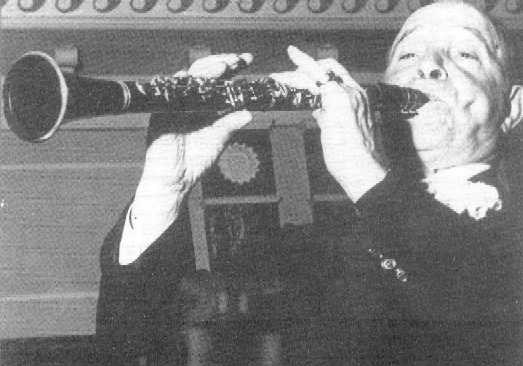 |
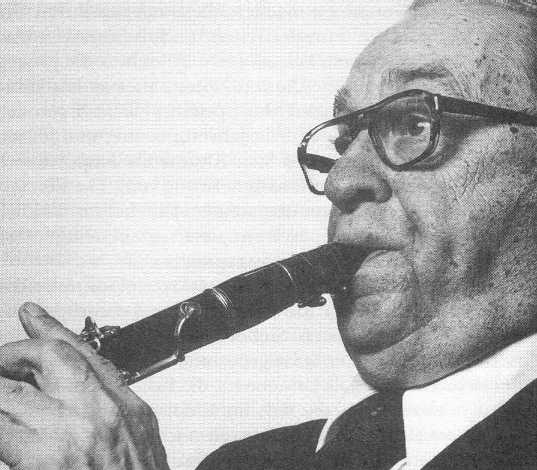 Tarras Tarras |
The first 78-rpm klezmer recordings made in Europe -and let alone in the US- (Belf's Rumanian Orchestra, H. Steiner, Max Yenkowits, Titunshnayder, Giter's Kharkov Orchestra, etc.) date only of the beginning of the twentieth century and they are not representing what klezmer was in past. They were full of scratches, pops and even musical mistakes that were part of their charm. Nowadays, it’s easy to correct electronically any imperfection, so tenuous it is, so that the recordings get a 'clean' or sometimes sterile sound that the listeners absolutely want to hear, even live on stage, though the emotions are repelled to an accessory role. Oy! Moderne tsaytn!
It's a fact that after the World War II and the Shoah, the inclinations toward cultural assimilation and Zionism among the North-American Jews secluded Jewish music to oblivion. Even klezmer giants have succumbed to the Israeli musical mode (1963, in the USA, the klezmer clarinetist Ray Musiker recorded "Tzena Tzena", "Hava Nagila", "Hevenu shalom aleykhem", etc.).
But in the 1970s, it was properly revived (Seth Rogovoy) or 're-energized' (Mark Slobin) in the USA and was called 'Klezmer' by the same way that Irish music was called 'Celtic'.
The Klezmer revival was due to classical, jazz, folk or pop musicians: Giora Feidman, Zev Feldman & Andy Statman, Henry Sapoznik ('Kapelye') or Lev Liberman ('The Klezmorim'). Most of them are Jews, tending to mark out a space for 'belonging' or identity or else to connect to their cultural roots, as if their souls were 'screaming for nourishment' (Andy Statman) or searching a valuable alternative to religious orthodoxy and to Zionism... but also Goyim (Gentiles), moved by the depth, the expressiveness and the universality of this music. Coming from the United States, this 'new wave' wasn’t long to reach Europe. It's actually a musical abstraction of the yiddish language" (David Krakauer) and "the picked soundtrack of a new culture for the Jewish youth" (Alicia Svigals). This way of thinking might reflect the reaffirmation of Klezmer's spirituality that has intensified in the late 1990's (Barbara Kirshenblatt-Gimblett).
The traditional Klezmer bands used to play mainly for dancing at 'simkhes' (celebrations) and the concept of a public sit-down concert is a new phenomenon since the revival (Ari Davidow).
Actually, one can schematically distinguish three streams in Klezmer music: The 'mainstream' musicians (The Epstein Brothers, The Maxwell Street Klezmer Band...) practice essentially in para-liturgical circumstances, like weddings or other Jewish feasts. Other 'traditional' musicians (Joel Rubin, Andy Statman, Di Naye Kapelye or Budowitz) tend to re-actualize the sound and the arrangements of the past. But for most of the contemporary klezmorim, the klezmer stage is an open stage where they can express their own spiritual universe, share artistic ideas and bring their own compositions, accepting the influences of all actual tendencies like jazz (The Klezmorim, The Flying Bulgar Klezmer Band, The New Klezmer Trio, David Krakauer, Kol Simcha, Klezmokum...), free-jazz (John Zorn, Eliott Sharp, Anthony Coleman...), pop music (Mickey Katz...), rock'n roll (The Klezmatics, Avi & Yossi Piamenta) and other kinds of 'ethnic' music: Indian, bhangra (Pharaoh's Daughter), Arab (Atzilut), Celtic, etc. Like in the past centuries, some Klezmer bands (Brave Old World, The Klezmatics, The Klezmer Conservatory Band, Kapelye...) use their (Yiddish!) songs to express their social, political and even sexual concerns and claims.
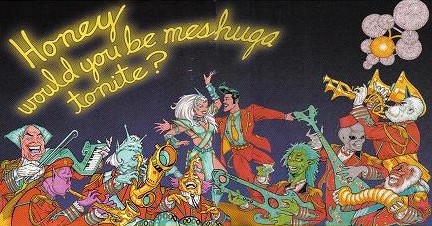
Klingon Klezmer
Since the 21th century, a special mention should be given to all these new contemporary Occidental tendencies that include klezmer or take inspiration from it: reggae, ska, hip-hop, drum'n bass, disco, techno, house, rap, ragga, jungle, etc: (Adonaï and I, Emunah, etc.
In Ukraine, in the eighteenth and nineteenth centuries, the Jews were only allowed to play on 'quiet' instruments (fiddle, 'tsimbl' and flute). 'Strong' ones (brass and drums) were eschewed. Furthermore, the number of musicians and the length of the concerts were also restricted.
 |
Di Shpilman Kapelye Ostrowiec, Poland ~1905
|
The violin ('fidl', 'werfl', 'warpli' or 'warfli' in Yiddish) was the most appropriate instrument for all kinds of ornamentation and expressive variations. In the sixteenth century, the violin was at the lowest place in the hierarchy of the musical instruments (but it was easier to flee a pogrom with a fiddle than with a piano!). The "ershter" (lead violin) of a 'kapelye' (orchestra) used to play the main melodic line on the top of the register. The 'tsweyter' (second violin) played an 'heterophonical' version, often one octave lower and the 'fturke' or 'secunda' made a rhythmical accompaniment (Josh Horowitz & Seth Rogovoy). The fiddle embodied the essence of Klezmer style and soon became the symbol of the Jewish music and the old Yiddish expression 'Yidl mit'n Fidl' inspired a famous song and a movie.
The flute ("fleyt" or "shtolper") was used since the 17th century. Mikhoel Guzikov played it before creating his 'shtroyfidl' in the 1830s. Piccolos were common among klezmorim, because cheap and easy to make. Flutes were usually conical although some were cylindrical, and probabily badly tuned and made in c, sometimes in Eb and F (Josh Horowitz).
 |
|
 |
| Adrianne Greenbaum 2004 |
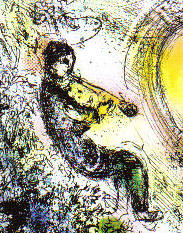 Marc Chagall 1968 |
The clarinet
('clarnet', 'foyal' or 'forsht') wasn’t adapted to
the Jewish 'kapelye' from classical orchestras nor replaced the
Hungarian or Transylvanian taragot (tarogato), but was brought in the
second half of the nineteenth century by (Jewish) musicians from German
and Russian (or possibly Napoleonic) military bands (Josh Horowitz,
J.B. Loeffler). The Klezmer clarinetist acquired a better social status than the fiddlers did. The moaning sound of the clarinet (especially the C-tuned) was perfectly adapted to the Jewish style. |
|
If many melodic instruments were present in the band, the higher (fiddle or clarinet) played the lead voice, the reverse was used only for short moments, to obtain a contrast effect. Instruments with identical registers played preferably one octave higher or lower (like in the Turkish 'tsiftetelli'), the unison being avoided because of the different pitches of the instruments. In opposition to long trilled notes, sometimes played over many bars, the third and the counter-chant were more sparingly used than nowadays (Merlin Shepherd): a question of (good) taste!
The cimbalom ( 'tsimbl'), a hammered dulcimer, was already popular in Galicia, Bukovina (Poland) and Belarus in the sixteenth century, but it’s not clear if it was brought by Jews, Gypsies or Hungarians. With a hundred strings, it was not easy to tune and the listener’s ears should have been more tolerant at that time than today!
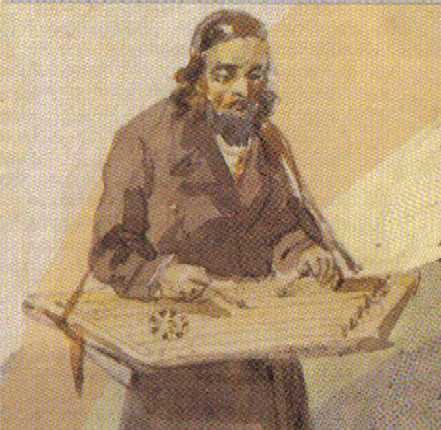 |
yiddisher tsimbler |
 |
| Pete
Rushefsky
and his tsimbl |
The accordion (sometimes: harmoshke) was expensive and rare but estimated in the late nineteenth century. Its key-frame with buttons, its bronze vibrating blades (actually they are made of zinc or aluminum), its little rigid goat leather bellow gave a soft, hot sound close to the human voice and allowed a large gamut of nuances and ornamentation but demanded strength to play it (Josh Horowitz).
The piano was seldom used by the old European klezmorim for, as a middle-class instrument, it was not easily available to poor people, for street music or at weddings. It became more present among the American immigrants at the end of the 19th century, as part of their socialization into the American life (Mark Slobin).
The cello ( ('tshelo' or 'barok'), lighter and more flexible than the double bass ('bas' or 'verbl'), with 4 or 3 strings, could be strapped to the shoulders during the processionals. The thumb wasn’t usually needed because the gut strings were not strongly stretched and the high notes rarely played. The bow was shorter, more curved and with less stretched coarse hair than nowadays. It was hold in the 'first position', in the middle. The instrument was supposed to sound like a 'burden' or a percussion, to give a greater sound volume in front of noisy listeners or dancers (Josh Horowitz). Later, under the influence of folk music and jazz, the bass line became more melodic, joining sometimes the lead voice or "ostinato" fixed to one or two notes (i.e. I - VI). When a double bass was included in the 'kapelye', the cello could also play the tenor voice.
The percussion was often reduced to a little drum ('tshekal') or a bass drum ('poyk', 'puk' or 'baraban'), sometimes with a cymbal ('tats').
Many other less typical instruments were included in Klezmer bands: brass, guitar, piano and later saxophones (considered by the nazis as instruments of the 'Jewish-Negro subversion'!), xylophone, banjo, tambourine, mouth organ, and even tablas, Indian sitar or didjeridoo!
![]()
The traditional Klezmer music contains characteristics of both secular and religious music.
![]()
Originally, the tempo was free and the fluctuations were played dependent of the atmosphere in the ceremony or among the listeners: it had to be faster when the ambient became hot and slower when a grandmother entered in the dance! (Josh Horowitz). Our actual concept of a precise and regular (not to say mechanical) tempo was introduced only with the time of the recording means, a hundred years ago. Like the Gypsies and some jazz musicians, the klezmorim were able to play the melodies 'forwards' or 'backwards' to the beat, producing a feeling of instability or a tension allowing some emotional expressions.
![]()
A) Major: Similar to the major mode of the occidental music and to the 'Ajam': maqam:

Example: 'Mayn shvester Khaye'. And in Judeo-Spanish music: 'Buena semana'.
The 'Rumanian major' mode adds some half steps: D D# E F F# G G# A B C D.
B) Minors: By definition, they all have a diminished (minor) third degree: C D Eb... or D E F...
B 1) Natural minor (Aeolian, Mogen Ovos), also referred as 'didactic mode': Similar to the 'Nahavend-Hijaz' maqam, it is build on the sixth degree of the major scale (like a major F scale beginning on D):

Examples: 'Moldavian Hora', 'Der Kiever Bulgar', 'Dem Trisker Rebns Nigun', 'Terk in Amerike' ('Fel shara' in the Judeo-Spanish repertoire) and 'Hatikvah', the national Israeli anthem....
B 2) Harmonic minor: Frequently used in Klezmer music. Related to the oriental maqam 'Nahavand-Kurd', it differs from the preceding by an augmented seventh:

The augmented second between the 6th and the 7th degrees increases the 'leading note' effect of the seventh and allow to play a major dominant chord (5th degree).
B 3) Melodic minor: this mode keeps the augmented seventh of the former, but 'corrects' the augmented second by augmenting the sixth: D E F G A B C# D
C) Typical Ashkenazic modes: The three following shtaygers are called after the prayer in which they appear. They are said to be connected to certain notions of ethos or emotional contexts. One of the salient characteristics of these shtaygers is the variety of tone and semitone series in the different octaves.
C 1) Ahava Raba (great love): Also called 'Freygish', altered Phrygian (#3) (Beregowski), 'Hijaz' (Arab maqam or mode). Idelsohn suggests that this mode is Tartaric (13th century). Its second degree is lowered, resulting in a tone-and-a-half step (augmented second) between the second and the third degrees. It is common to many eastern European, Jewish and non-Jewish folk tunes and sounds similar to the phrygian mode (often used in Spanish music, built on the third degree of the major scale, like a Bb scale beginning on D), but contains a major third degree:

Examples: 'Tantzt, tantzt, yidelekh', 'Lebedik un freylekh', 'Sherele', 'Ot azoy', 'Shpil-zhe mir a lidele in yiddish' and even 'Hava Nagila', an old Sadegurer Hasidic tune, adapted to the Israeli fashion! And in Judeo-Spanish music: 'Cuando el rey Nimrod' and 'Los bilbilicos'.
The Arab maqam 'Hijaz Kar'
(a Phrygian #3 #7 scale) differs
only within another augmented second between the sixth and the seventh
degrees: D Eb F# G
A Bb C# D (Pierre Cormon) and is
sometimes used in Klezmer.
Example: 'Misirlou'.
We find the same mode (raga) under the name
of Maya malawagowla in Indian music (Rama Jonnalaggeda).
C 2) Mi sheberakh (the one who blesses): also called 'Av horakhamim', Ukrainian Dorian (Idelsohn), altered Dorian (Beregowski), Dorian #4, 'Slikha', 'Doina' and close to the Greek karagoona and nigriz and also to the maqam nikriz. It's the harmonic minor scale, beginning onthe 4th degree:

Examples: 'Di sapozhkelekh', 'Nokh a gleyzl vayn', 'Odessa bulgar', 'Freylekhs fun der khupe' or the 2nd part of 'Gasn nigun'... It's commonly found in Jewish Doinas. The fifth and sixth degrees have an important expressive purpose (David Krakauer). The 6th and the 7th degrees are sometimes augmented or diminished.
In these two modes, like the 'blue notes' in jazz, the augmented second gives to the Klezmer music a typical 'oriental' consonance.
C 3) Adonoï molokh (God king), also called 'Tefila' (prayer) by sefardic cantors, 'Rumanian major' or Myxolydian: Similar to the Arab mode "siga", it is built -in the main octave- on the fifth degree of the major scale (like a G scale beginning on D)

It is played on 7th chords and has sometimes a minor 10th: D E F# G A B C D (E F). The underlying tonic chord (key center) can be minor (G Bb D) or major (G B D).
Examples: 'Baym rebn in Palesteena', 'Rumenia Rumenia', 'Der shtiler bulgar'.
C4) Yishtabakh, a minor mode, rarely used, with diminished 5th and 6th (and sometimes 2th) degrees.

C5) Other modes like Yekum Purkan, Akdamut or Amida (pentatonic) are used in cantillation but rarely in Klezmer music.
![]()
As usual in an oral tradition, the tunes were played without any composer's credit and even without titles. The musicians often only called them by naming the rhythm ('freylekhs' or 'hora'). Entitling became necessary only with the advent of the recording. Most of the titles refer to the state of mind of the musicians: 'Nokh a glezl vayn' (one more glass of wine), 'Nakhes fun kinder' (rejoicing about the kids), "Der arbetsman" (the worker), etc.
Before this era, musicians would name a tune after its rhythm ('freylekhs', 'bulgar', 'sher' or 'hora'), its tonality ('C minor bulgar') or after the name of the musician who taught it ('Bughici's sirba', 'Goldenshteyn's freylekhs', etc.) (Hankus Netsky).
The duration of the tunes was not limited, but had to be adapted to the circumstances: If the audience was dancing, the klezmorim were required to enchain 2, 5 or 10 bulgars without a pause! (Max Epstein). The brevity of a 78-rpm's side imposed to the musicians the 3 minutes limitation of a tune that remains usual nowadays.
The improvisation was part of the liturgical Jewish music as well as of the Klezmer music.
At the beginning, the purpose was just to modify the phrasing, the articulations or the ornamentation of a melody, or to add some "krekhtsn" (ornaments). This is heterophony: Like a Jew praying with others, each musician of the band tells the same story but his own way and... let's meet again to the end of the tune!
The tempo changes and rubati are already to be considered as a kind of improvisation. The taksim and the doina are long slow semi-improvisational and rubato melodies. In these kind of pieces one can feel a major influence of the liturgical cantillation of the khazan (cantor).
The concept of improvisation evolved obviously in the twentieth century under influence of the jazz with choruses based on the chord chain of the theme or even modal free improvisations.
Most of the themes one can hear nowadays are considered as "traditional", i.e. that the author is not known or... forgotten. His name could have been lost due to the oral transmission of the tune; or the composer was perhaps acting as a rebbe or an artisan, not as an artist; or he was simply unable to register his work.
Many melodies are not definitively considered as
achieved and they evolve with the
consecutive interpretations. One tune can have many titles: ('Moldavian Hora' and
'Bolgarskii Zhok',
'Gasn Nigun' and 'Nationale
Hora', or 'Pedotser’s
Tants',
'Tanets Rabina'
and 'Der Khosid Tantzt').
One of the most common klezmer tunes,
'Tantzt, tantzt, yidelekh', is known under many
other names: 'Reb
Dovidl's
nigun', 'Der
rebbe hot geheysn freylekh zayn',' Yoshke ma yofi'…
and even in
other languages: 'Hariklaki
mou', 'Baile
nupcial ebreo', 'Oj
pidu ja wikher
shiker', 'Jewish
melody', 'Tire,
tire l'aiguille, ma fille'…
The NIGUN (from the Hebrew 'lenagen': play music) is a simple, wordless and easy to remember, often religious folk tune, usually composed by a rabbi or a member of a 'hoyf' (rabbinical court), sometimes borrowed from the local folk or foreign tunes and 'sanctified' ('mekadesh zayn a nign')! Sung repetitively and with 'kavanah' (concentration) by all the members of a community, it bears (among prone subjects!) a kind of mystic ecstasy. A 'tish nigun' accompanied meals, a 'nigun rikud' was appropriate for dancing, a 'nigun simkha' was for expressing joy, the 'Deveykus nigun', often arrhythmic, was dedicated to God, the 'Gasn Nigun' used for the processionals and the 'treredike nigun' for meditation and crying (Andy Statman). The nigunim are usually sung with onomatopoeia: 'bim, bom' around Modzitz (Galicia), 'ay di gi day' in Ger, 'Ti la lidl la li la lo' in Karlyn, 'lay lay lay' in Bobov, 'oy la la' or 'yom pa, tigidigi day' in Nikolayev, 'oy, yoy', 'na-na-na', 'ma-ma' or 'moy na-na' in Lubavitch, etc. (Henry Sapoznik, Lorin Sklamberg, Frank London, Yale Strom).
The
nigun is a song with an instrumental fashion or style: The
voice is imitating a
musical instrument, that is not allowed to play on shabbes.
It can be sung at a
table (tish nigun) or standing and dancing, but
always shokling, which
helps to be inside and eventually get lost in the melody. A bit like in
a protest
song, the energy comes from repetition. The nigun
has to be repeated
almost endlessly. Never let the energy drop and fill the space with oy
oy oy’s! In
addition, without going as far as improvisation, the melody leaves
everyone a freedom of rhythmic melodic interpretation. (Sruli Dresdner)
Some Hassidim thought that it was possible to
weaken their enemies by singing
their hymns in a religious way (ex: La Marseillaise!) (Frank London)...
Thus, the typical
'bridge'

very common among the Hassidic melodies of Ukraine is just a parody of a drum roll (Lorin Sklamberg).
The FREYLEKHS ('joyful' in yiddish), also called 'hopke' (jump), 'redl', 'karakhod', 'dreydl', 'kaylekhiks' or 'rikudl', is a lively but spiritually marked Jewish circle dance, to which a lyrical joyful piece, played in a rhythm of 2/4 or 4/4, is to be played. The steps could vary from onr region to another, letting a place for improvisation (Nathan Vizonsky). Freylekhs could also qualify a lyrical piece in a joyful mood. More about the dance?
The BULGAR (from 'bulgaresti' or 'bulgareasca' : in the Bulgarian way (Zev Feldman)) is musically related to the Freylekh, although usually a bit slower and more complex. It is a dance from Bessarabia (Romania) -and not from Bulgaria where most of the Jews were Sephardim!- quite similar to the Sirba (sarba), the gypsy chochek (cocek), the Greek hasapiko or the Israeli hora, done in circle, in line or in couples. It was very popular in the United States in the first half of the 20th century. It is played on a lento, medium or fast tempo in 8/8 with accents on the first, fourth and seventh quavers (123 456 78), giving a special rhythmic feeling. More about the dance?
The KHOSIDL is a dance in Hasidic style (imagine them with their 'peyes' (sidecurls), long beards, black caftans and hand elevated to the heaven!), often very expressive and in a spiritual mood, based on a folk tune in 2/4 or 4/4 (sometimes called zemerl). It usually begins at a moderate tempo and accelerates progressively to reach an ecstatic enthusiasm. More about the dance?
The HORA
(also called 'slow hora', 'Rumanian hora',
'zhok', 'londre', 'volakh' or 'krimer') is a Rumanian circle dance,
originally in 5/3 but
often played in triple meter (3/8 or 3/4), with accentuation on the
first and the third
beats:

Examples: Bessarabian hora = Nokh a glezl vayn, Moldavian hora =
Bolgarski zhok, etc.
The dance was very popular in Moldavia, Bukovina, Podolia and some
regions of Ukraine. More about the dance?
The rhythm was not always played metronomically, so that it could
suggest a 5 beats
setting.
Some hora themes were also used for informal processionals. Examples:
Firn di mekhutonim
aheym, Gasn nigun. (to let the in-laws and the guests know that they
had to get back home
and leave the newly married couple alone at the end of the wedding...)
The slow hora is not to be confused with the Israeli Hora, (i.e. Hava
naguila) which is a
kind of fast bulgar!
FYI: 'Hora Mare' means 'big hora' and 'Hora Lautaresca': 'hora the
Gypsy way' (Marianne
Entat).
The TERKISH rhythm is similar to the Greek (KRITIKOS) SYRTOS, BALLOS or SUSTA, to the Turkish TSIFTETELLI and to the Spanish HABANERA. It’s a 4 beats tune with an oriental consonance and a rhythm 'crotchet -quarter rest - quaver - crotchet - crotchet' or 'crotchet - dotted quarter rest -sixteenth - crotchet - crotchet' which sounds even more oriental (Marianne Entat). The Sirtos was possibly to be heard in Eastern Europe, but not for Jewish dancing (Josh Horowitz) though melodies on this rhythm were used as ritual music for the guests at weddings (Zev Feldman). It became popular in the first half of the 20th century in the USA (after Naftule Brandwein, Dave Tarras, etc.) and Jews began to dance on it. More about the dance?
The SIRBA is a Rumanian (Moldavia, Oltenia) couple or line dance on a fast tempo in 12/8 with a feeling of triplets (123-123-123-123) in the rhythm or in the melody (Marianne Entat).
The SHER (also 'sherele, 'volzeni', 'hakhnoe'), a German shepherd’s couple dance, is similar to the American square dance or to the Russian quadrille ('krokadil'), played in 2/4 at a medium or fast tempo, like the Freylekh. The name ('scissors') is not an allusion to the movement of the legs (which is the case of another Russian dance called 'scissors'), but more likely to the pattern dancers trace when they cross each other (Helen Winkler). Other etymological suppositions: The sher could be the traditional dance of the barbers or of the tailors (Michael Alpert), mean 'Shar-tantz' (popular dance or group dance) or be related to the ceremony of cutting the bride's hair before the wedding (Josh Horowitz). Interesting to notice that the sher was not danced east of Moscow, where the Napoleon's armies didn't make their way!(Leon Blank).The numerous themes called 'sher' are often a compilation of a few sections put together to form a more or less long piece, depending of the dancer's need. More about this dance?
The TAKSIM, widely used in Arab, Turkish and Muslim Balkanic countries is an improvisational tune in a 'makam' mode, based on the melody of the following tune (but can occasionally be played in the middle of the tune). It was replaced (according to the ethnomusicologist Moisei Beregowski - Kiev1892-1961) in the late 19th century by:
The DOINA is originally a Rumanian shepherd's lament with Greek influence (skaros or kleftika) and was already borrowed by the Gypsy 'lautari'. The term 'doina' could derive from the Sanskrit (Indian) 'd'haina', recalling the Gypsy influence on this music (Yale Strom). It is a rather slow tune, improvised, free-metered (rather than unmetered) or with a regular rhythmic pulse (Kurt Bjorling), often employing sequences of short melodic figures. The soloist (often fiddle or clarinet) plays on a soft harmonic (modal) basement (tsimbl or accordion). When requested, the chord changes were indicated at the moment, musically or by sign, to the other musicians by the soloist (and not by the band!). This style is particularly conducive to express alternating or mixed feelings of sadness and joy. It includes the intonations and melisma of the 'Khazanut' (synagogal cantillation) or those of the poetic prosody used by the 'badkhn' to bless, moralize and make the bride cry. In a medley, the doina was often used as a 'forshpil' (prelude), followed by a short rhythmical 'tsushpil' announcing a tempo change (for example terkish) towards a faster piece or suite called 'nokhshpil' (hora, khosidl, sirba, terkish or bulgar). More about the doina here!
If the listeners or dancers asked (and paid!) for, the klezmorim could also play
- the KOLOMEYKE (a fast Ukrainian couple dance with accents on the two last notes of the phrases)
- the Ukrainian HOPAK (with accents on the two first notes of the phrases)
- the SKOTSHNE
(a salting two-beats dance, similar to the freylekhs
with some more virtuosic elements (Beregovski), which name (and
melodies?) could allude to
Scottish missionaries in Moldavia in the nineteenth century or to the
Schottish dance, but definitely comes from the
Polish 'skakać' or
the Ukrainian 'skakaty', meaning 'jump' (Merlin Shepherd, Christian
Dawid). Others ascribe to it a Czech origin... The term was
mainly used by klezmorim and fewer by the audience. Musically, the
skotshne is a 'black
hole' including Hasidic 'table' or 'court' melodies,
dancing tunes, music to escort the bride and groom to the khupe,
etc. (W.
Zev Feldman)
- the HONGA (a dance in line called hangu bay the Moldavian shepherds, with repeated 4- or 8 bars motives in eighths) close to the Bulgar
- the Hungarian CSARDAS (on a slow then fast tempo)
- the Russian KASATCHOK
- the FANTASY (suite of free form, rhythmical or arrhythmic tunes without religious intention, to be heard during a meal)
... or any light classical themes. Other modern styles were also occasionally played: gavotte,quadrille, tango, waltz, march, polka (2/4), mazurka (3/4), and even fox trot, ragtime, rumba, merengue, samba, roch'n roll, jazz themes and light classical pieces.
Listening to the music is much better than
reading
a theoretical explanation! It's
very difficult (and boring)
to write down music exactly as it was played by such or such musician,
especially after an old recording: the ornaments, articulations,
inflexions and
other musical nuances would be more numerous than the notes! However a
few peculiarities should be mentioned for
musicians who discover the Klezmer music with sheets.
- Long notes are often (but not always!) 'bent' or embellished with trills.
- Fiddlers but also other instrumentalists often use glissandi, but usually not in imitation of a hooter, as in George Gershwin's Rhapsody in Blue!
- Vibrato was introduced late and sparingly due to the influence of classical music (Walter Zev Feldman).
- Eighths are to be played equally (binary), except for some special pieces ("Rusishe sher") and, of course, in jazz-influenced tunes ('Bay mir bistu sheyn', 'Abi gesunt', 'And the angels sing', etc.) where ternary beat is needed.
- Triplets are sometimes articulated equally (as classical triplets), sometimes like a figure 'sixteenth - sixteenth - eighth' and more often... in between!
- Repeated notes in pairs (Joshua Horowitz uses the metaphor of a toddler staircase, where the child walks down with the same foot on the lower step at each step!) are often played, especially in a descending scale to reach the tonic: D C C B B A A G# G# B A G# F E D. This stylistic device, frequently used in the “kale bazetsn” and particularly “kale baveynen” part of the Jewish marriage is often found in doina (and possibly in taksim), but also in many klezmer themes, where this filiation appears clearly, either in the melody or in the harmonization.
- The cadence which announces the end of a phrase or of a part of a piece is often preceded by a "pre-cadence", in the form of a mode change, readily with a flat second degree (IIb) (Joshua Horowitz).
- The melody is often played a little bit before or sometimes after the beat, to give a certain rhythmical tension.
- The hopke is a musical figure characterized by a jump to a short upper octave note, followed by a long 5th (Ex. Moldavian hora, Sirba gute nakht, Kolomeyke 15...). Common in klezmer themes, but not exclusive!
- Many tunes have a typical ending with a wide ascending glissando and a descending chord chain 'I-V-I' (or 'VIII-V-I'), played a tempo or preferably rallentendo (slower). This formula was perhaps created to imitate the ending of some symphonies, but was mostly practical to finish quickly a tune when it was needed in a ceremony (i.e. at the entry of the bride, when a gift was announced, etc.) or at the end of an old 3 minutes recording roll.
And last but not least:
- Embellishments: 'Krekhts' (sigh, groan, moan, sob...), 'glitsh' (portamento or short glissando towards the shrill), 'dreydl' or ou 'shleyfer' (grupetto), 'tshok' (click), 'kvetsh' (complain) or 'kneytsh' (bends), 'boydt'ia' are only few of the numerous Yiddish names for typical and specific (Mark Slobin) shaping of notes in Klezmer music that reveals its cantorial origin ('khazones'). But 'you can't let the ornament overtake the melody' (Max Epstein) and 'you can't go wrong if you leave something out' (Deborah Strauss). 'Regard ornaments as spices which may ruin the best dish...' (C.P.E. Bach, quoted by M.Slobin). For more information about ornementation, see "Shpil, the Art of playing klezmer" de Yale Strom.
Examples of klezmer embellishments:
The difficulty is not to play the ornaments, but to play them right.. But 'never play it twice the same way - never!' (Max Epstein).

Spirituality, heterophony, ornamentation, special phrasing, scales with augmented seconds and other above mentioned features don't define Klezmer music entirely, but are some of its characteristic points.They obviously also exist in other musical styles.It is their assembly that makes klezmer music unique and easily recognizable.
Klezmer is so close to the cantorial (synagogal) singing that it seems religious, even if it's not. (Alicia Svigals). But 'Among Jews, music is not only an art in itself: it aims to lift the human soul to God.' (Moshe Mussa Berlin). And 'lakhn mit trern' (laughing with tears) is part of 'dos pintele yid' (the essence of being Jewish) (Seth Rogovoy, Yosl Kurland) because 'If too much joy lead to bestiality, too much sadness leads to death!' (Hasidic proverb).
![]()
![]() 2020-05-15
2020-05-15
![]()
.